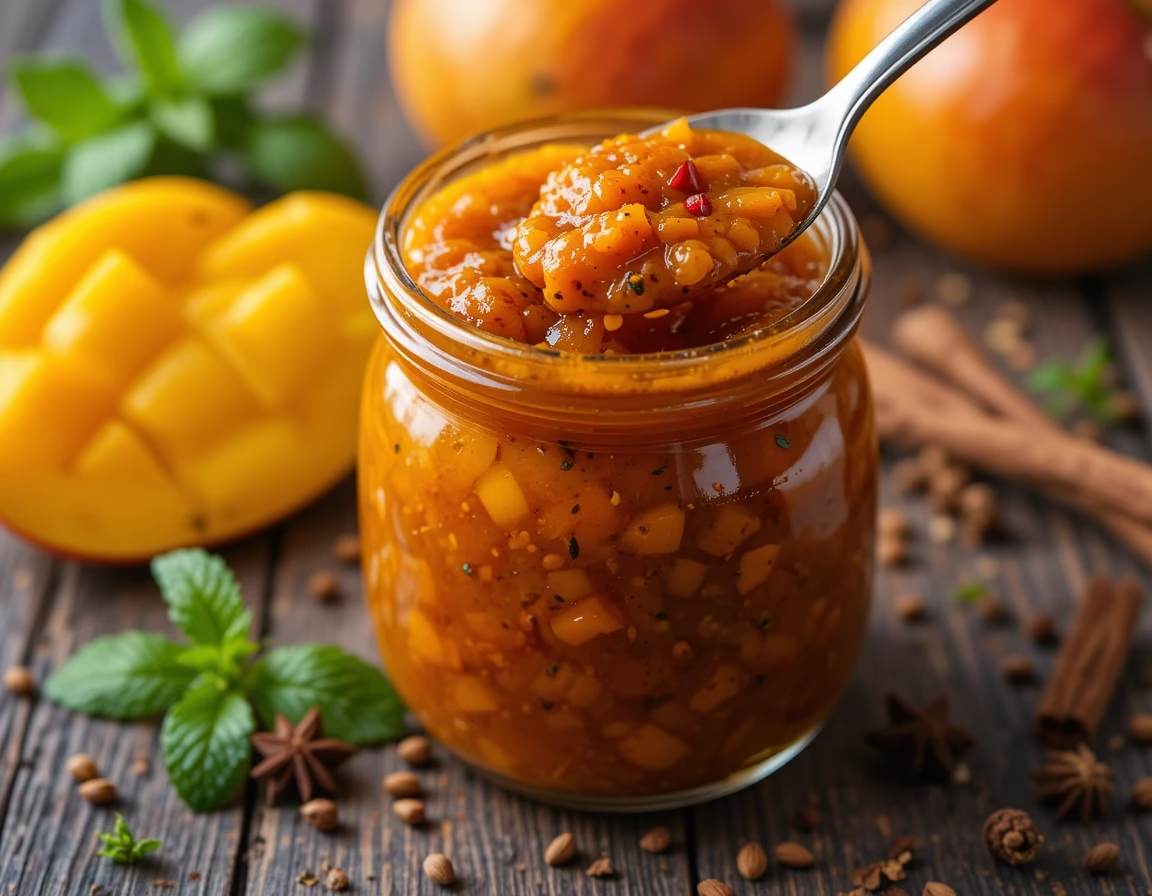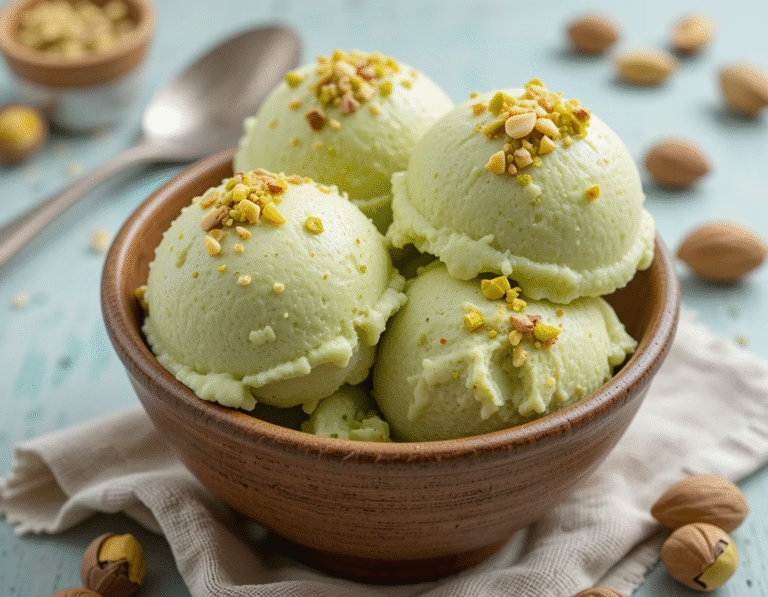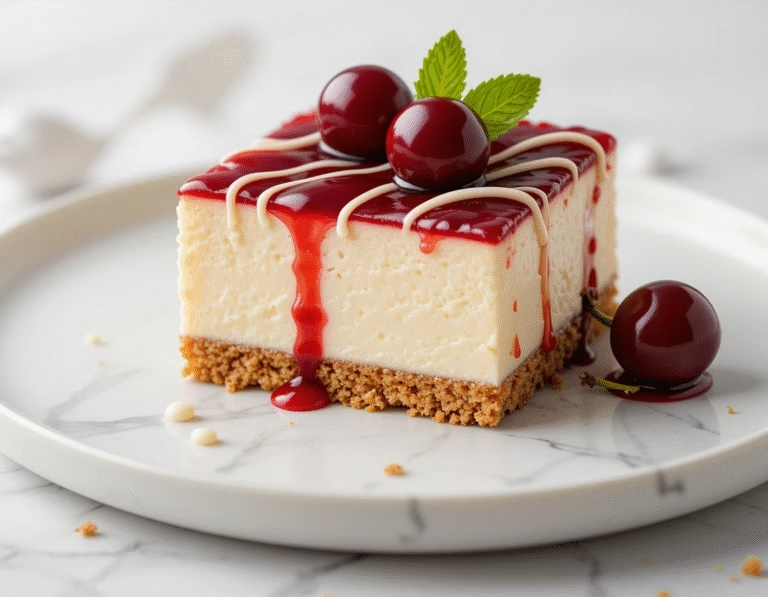Easy Homemade Mango Chutney
If you’re craving the perfect balance of sweet, tangy, and spicy, homemade mango chutney is the way to go. This versatile condiment elevates everything from grilled chicken to cheese plates, tacos, and veggie wraps. Unlike generic store-bought versions, your own mango chutney brings fresh fruit flavor, real texture, and controlled sweetness. Each batch of mango chutney bursts with tropical ripeness—perfect when mangoes are in peak season, yet timeless for indulgent cooking year-round. It’s not just a condiment; it’s a flavorful experience that starts with simmering juicy mangoes and ends with mouthwatering complexity on your plate.
What makes mango chutney so special is its ability to enhance everyday meals with minimal effort. You can spoon it over roasted pork tenderloin or stir it into rice for a quick twist. Homemade mango chutney blends chunks of fruit with cumin, ginger, mustard seeds, and sweeteners to create that signature warm and flavorful mix. Versatile, homemade mango chutney works just as well as a pizza topper or a flavorful spread on grilled cheese. The condiment’s charm is built on multidimensional taste—sweetness, sourness, spice—all captured in one small jar.
The best thing about making mango chutney at home? You’re in control. Want it fiery hot? Add more chilies. Prefer milder, more aromatic notes? Dial down the heat and add extra ginger. Need to reduce sugar? You can manage exactly how sweet your mango chutney turns out. When you make mango chutney yourself, there’s no artificial thickener or preservatives—just nature’s best, simmered down to perfection.
What You’ll Need
Creating your own mango chutney is easier than you think, and the results are nothing short of spectacular. Before you begin, gather your ingredients and tools—this ensures a smooth cooking process from start to finish. Homemade mango chutney relies on fresh, ripe mangoes, balanced spices, and a few pantry staples to achieve its signature texture and flavor.
Ingredients for Mango Chutney
- 4 cups fresh mango, peeled and diced (about 3 large mangoes)
Start with ripe but firm mangoes for the best texture in your mango chutney. Overripe mangoes can become mealy and make the chutney mushy. - 1 medium onion, finely chopped
Onions bring a savory base note that complements the sweetness of mango in your homemade mango chutney. - 2 cloves garlic, minced
Garlic adds aromatic warmth—a classic element in top-notch mango chutney. - 1 tablespoon fresh ginger, finely grated
Fresh ginger adds zing and brightness to your mango chutney, elevating its complexity. - 1 jalapeño pepper, seeded and chopped (optional)
Adjust spiciness in your mango chutney by removing or keeping seeds. - ½ cup apple cider vinegar
Acidity helps preserve your mango chutney and balances its sweetness. - ½ cup brown sugar (light or dark)
This sweetener caramelizes during cooking, giving your mango chutney depth and golden color. - 2 tablespoons raisins or golden raisins
Raisins add chewy texture and natural fruit sweetness to your mango chutney. - 1 teaspoon mustard seeds
These add an earthy, nutty pop to every bite of your mango chutney. - ½ teaspoon ground cumin
Cumin warms your mango chutney with a subtly smoky profile. - ½ teaspoon ground coriander
Coriander brings citrus notes that highlight the mango in your mango chutney. - Salt and black pepper, to taste
Essential seasonings to bring your mango chutney into flavor harmony.
Tools and Equipment
- Large heavy-bottomed saucepan or pot – for simmering down your mango chutney evenly.
- Sharp chef’s knife and cutting board – to prep fruit and veggies for your mango chutney.
- Wooden spoon or heatproof spatula – for stirring without scratching your pot when making mango chutney.
- Measuring cups and spoons – essential for replicable flavor in mango chutney batches.
- Sterilized glass jars – for storing your finished mango chutney (great for gifting or pantry use).
How to Make Mango Chutney (Include Full Measurements)
Making mango chutney from scratch is a simple, satisfying process that fills your kitchen with warm, sweet, and tangy aromas. The key to a well-balanced mango chutney lies in simmering the right blend of fruit, spices, and acidity. With just one large pot and a few basic ingredients, you’ll create a batch of mango chutney that’s rich in flavor and versatile enough for dozens of meals.
Full Measurements for One Standard Batch:
- 4 cups mango, peeled and diced (about 3 large ripe mangoes)
- 1 medium onion, finely chopped
- 2 cloves garlic, minced
- 1 tablespoon grated fresh ginger
- 1 jalapeño, seeded and chopped (optional for heat)
- ½ cup apple cider vinegar
- ½ cup light brown sugar
- 2 tablespoons raisins or golden raisins
- 1 teaspoon mustard seeds
- ½ teaspoon ground cumin
- ½ teaspoon ground coriander
- ¼ teaspoon ground cinnamon (optional)
- Salt and black pepper, to taste
Step-by-Step Instructions:
- Prep the mangoes: Start by peeling and dicing your mangoes. You want chunks that are bite-sized but not too small—about ½-inch cubes work well. Firm, ripe mangoes are best because they hold their shape as your mango chutney simmers.
- Heat the pan: In a large saucepan over medium heat, add a small drizzle of neutral oil. Toss in the mustard seeds and allow them to pop for 30 seconds. This step adds deep flavor and texture to your mango chutney base.
- Sauté aromatics: Add the chopped onion, garlic, ginger, and jalapeño (if using). Sauté for 3-5 minutes until the onion becomes translucent and fragrant. The aroma at this stage will be the backbone of your flavorful mango chutney.
- Add mango and spices: Stir in the diced mango, cumin, coriander, and cinnamon. Let it cook for 2-3 minutes to infuse the fruit with spice. You’re layering flavor now to give your mango chutney that signature depth.
- Pour in vinegar and sugar: Add the apple cider vinegar, brown sugar, and raisins. Bring everything to a boil, then immediately reduce the heat to a gentle simmer. The mango chutney should gently bubble as it thickens.
- Simmer and reduce: Let the mango chutney simmer uncovered for 35–45 minutes, stirring occasionally. As the liquid reduces and mango softens, the mixture thickens into a jam-like consistency. Taste and adjust salt and pepper.
- Cool and store: Once your mango chutney reaches a rich, sticky texture with visible chunks of mango, remove from heat. Let cool slightly before transferring to sterilized jars. Store in the fridge once completely cooled.
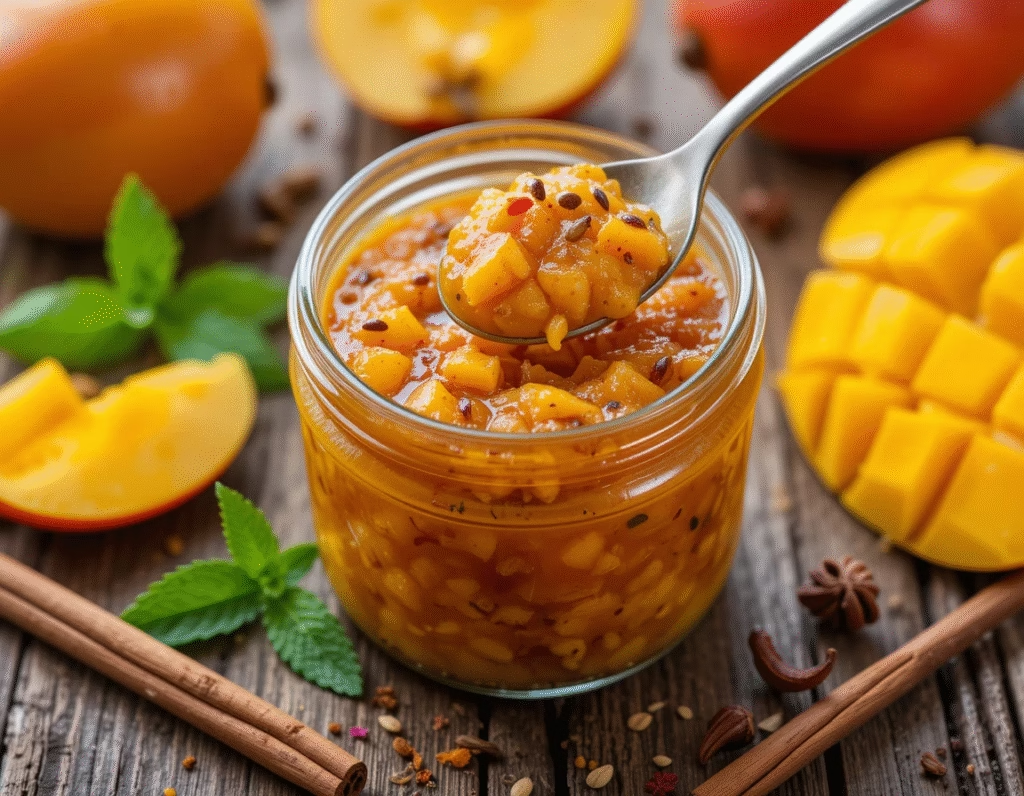
Want softer crumb texture? Our article on Peach Cobbler Topped Cheesecake explains how.
Serving and Storage Tips
Once you’ve crafted a perfect batch of homemade mango chutney, the next step is knowing how to serve it, pair it, and store it. Fortunately, mango chutney is a multitasker in the kitchen—delicious served warm, room temp, or cold, and it shines in both savory and sweet applications.
How to Serve Mango Chutney
- As a dip: Scoop a generous dollop of mango chutney alongside samosas, spring rolls, or tortilla chips for a zesty contrast to crispy textures.
- On cheese boards: The sweetness of mango chutney pairs beautifully with sharp cheddar, creamy brie, or tangy goat cheese. A spoonful next to nuts and crackers adds color and flavor.
- With grilled meats: Use mango chutney as a topping for grilled chicken, turkey burgers, or roasted tofu. Its fruitiness balances smoky charred flavors perfectly.
- In sandwiches and wraps: Add a layer of mango chutney to turkey sandwiches, veggie wraps, or even quesadillas. It brings unexpected tang and moisture.
- Over rice or grains: Stir mango chutney into basmati rice or quinoa for an instant flavor boost—great for vegetarian meal prep.
- As a glaze: Mix mango chutney with a splash of orange juice and brush it on baked chicken or roasted carrots in the last few minutes of cooking for a sticky-sweet glaze.
- With eggs: Spoon mango chutney over scrambled eggs, frittatas, or omelets for a breakfast with tropical flair.
Storage Guidelines
- Refrigeration: Store homemade mango chutney in airtight glass jars in the refrigerator. It will keep for up to 3–4 weeks, thanks to the vinegar and sugar, which act as natural preservatives.
- Freezing: If you’ve made a large batch, you can freeze mango chutney in freezer-safe containers. Leave a bit of headspace, as it will expand slightly. It stays fresh for up to 3 months. Thaw overnight in the fridge before using.
- Canning (optional): For long-term storage, you can use proper water-bath canning techniques. Sterilize jars and lids, fill with hot mango chutney, and process in boiling water for the time appropriate to your altitude and jar size.
- Batch portioning: Divide your mango chutney into smaller jars to use one at a time and avoid frequent opening and exposure to air.
Mistakes to Avoid
Even though mango chutney is fairly simple to prepare, there are a few common mistakes that can compromise its flavor, texture, and shelf life. Whether you’re making mango chutney for the first time or it’s a regular part of your meal prep, steering clear of these pitfalls will ensure success every time.
1. Using Unripe or Overripe Mangoes
One of the biggest mistakes in making mango chutney is selecting the wrong type of mango. Using mangoes that are underripe can result in a sour, tough chutney that never softens, while overripe mangoes break down too quickly, resulting in mushy, overly sweet mango chutney that lacks texture. Always choose ripe but firm mangoes that give slightly under pressure and have a fragrant aroma.
2. Skipping the Simmering Time
It’s tempting to speed up the process, but mango chutney needs time to develop its complex layers of flavor. Cutting the simmering time short can leave you with a watery or undercooked mixture where the vinegar hasn’t mellowed and the sugar hasn’t fully caramelized. Simmer low and slow for at least 35–45 minutes to get that thick, glossy finish your mango chutney deserves.
3. Overpowering the Mango Flavor
Mango chutney should highlight the tropical sweetness of the mango—not bury it beneath too many strong spices. While spices like cumin, mustard seeds, and ginger enhance the chutney, overdoing them will dominate the flavor profile. Balance is key. Taste as you go, and let mango be the star of your mango chutney.
4. Not Stirring Regularly
Because mango chutney thickens as it cooks, it can stick to the bottom of your pot or scorch if left unattended. Stir every few minutes, especially toward the end of the simmering time. A scorched bottom not only ruins the texture—it adds a bitter flavor that can affect your entire batch of mango chutney.
5. Poor Storage Practices
If you’re not refrigerating your homemade mango chutney in an airtight container—or if you’re using a contaminated spoon to serve—it won’t last long. Always transfer your mango chutney to clean, sterilized jars and refrigerate once it cools. Label each jar with the date so you know when to use it by.
6. Ignoring Acidity and Sugar Levels
Acidity and sugar aren’t just for taste—they also preserve your mango chutney. Skimping on either can shorten its shelf life and affect food safety. Make sure to measure both carefully and don’t cut corners, especially if you plan on storing your mango chutney for more than a few days.
Tips and Tricks
Perfecting your mango chutney comes down to small adjustments and clever tricks that take your cooking to the next level. These kitchen-tested tips will help ensure your mango chutney comes out amazing every single time, whether you’re making it for personal use or gifting it to friends and family.
1. Use a Mix of Mango Varieties
For a richer, more complex mango chutney, try combining different types of mangoes. Use one extra sweet variety (like Ataulfo or Honey mango) and one with a firmer texture (like Tommy Atkins). The sweet mango breaks down into a thick jam-like base, while the firmer one keeps some texture and structure. This creates a more dynamic mouthfeel for your mango chutney.
2. Enhance Flavor with Toasted Spices
Before adding your dry spices like cumin or mustard seeds, toast them briefly in a dry pan. Toasting brings out the essential oils in spices, deepening their flavor. Adding toasted spices early in the cooking process will infuse the entire mango chutney with a rich, aromatic backbone.
3. Customize the Heat Level
Tailor the spiciness of your mango chutney to your taste. For a mild version, use sweet bell pepper or skip chili entirely. For medium heat, include one jalapeño or red chili. If you like it hot, go for Thai bird chilies or a pinch of cayenne. Just remember: a little goes a long way, especially once the mango chutney reduces and concentrates.
4. Add Depth with Natural Sweeteners
While brown sugar is traditional in mango chutney, try experimenting with natural sweeteners like coconut sugar, honey, or maple syrup. Each brings its own unique character—coconut sugar adds a caramel-like flavor, honey adds floral notes, and maple gives a deeper earthy tone to your mango chutney.
5. Stir in Dried Fruits or Nuts
To boost texture and flavor, stir in chopped dried fruits like apricots, cranberries, or dates near the end of cooking. You can even add slivered almonds or cashews for a little crunch. These mix-ins turn your mango chutney into an elevated condiment perfect for special occasions.
6. Puree for a Smooth Version
If you prefer a silky texture, blend the finished mango chutney with an immersion blender until smooth. This works especially well if you plan to use your mango chutney as a spread or dipping sauce. Always cool slightly before blending to avoid steam burns.
7. Double or Triple the Recipe
Mango chutney freezes beautifully, so it’s worth making a double or triple batch. Whether you’re stocking your freezer or preparing edible gifts, a large-batch mango chutney effort pays off. Just be sure to use a wide pot and stir often to ensure even cooking.
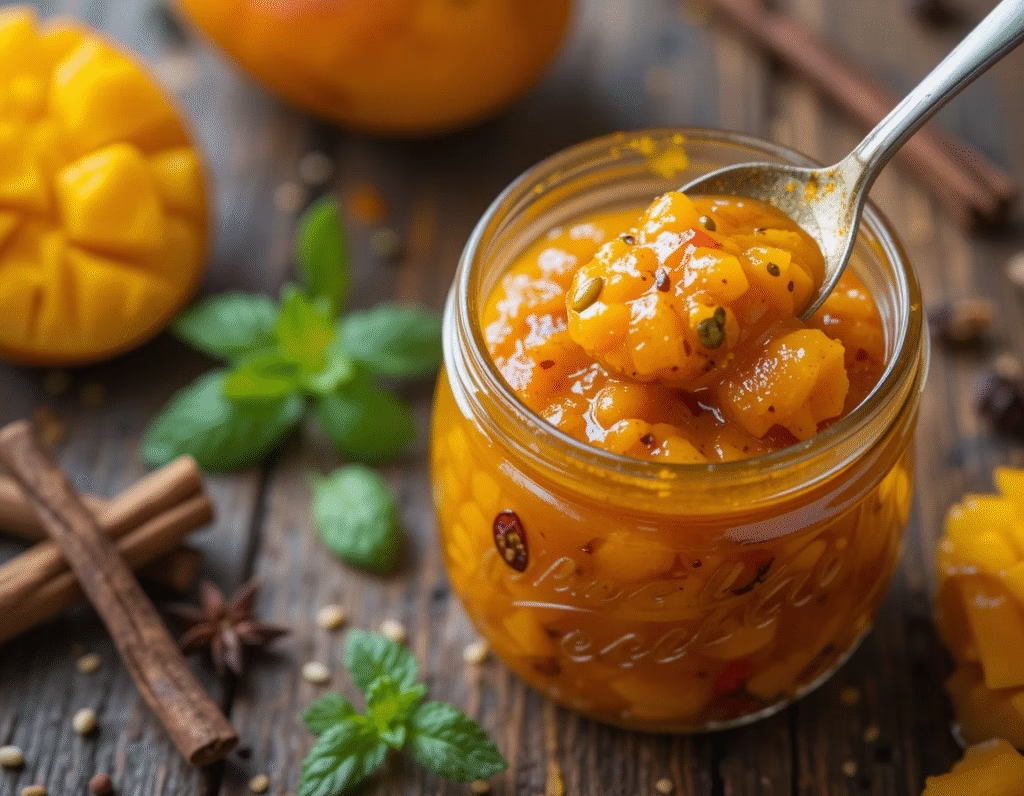
Suggestions
Mango chutney isn’t just a condiment—it’s a creative culinary powerhouse that adds sweetness, tang, and a burst of flavor to countless meals. Whether you’re serving it with a simple snack or incorporating it into gourmet recipes, there are endless ways to enjoy mango chutney in your everyday kitchen routine.
1. Pair with Cheese Boards
One of the most popular and elegant ways to serve mango chutney is alongside a cheese board. Its sweet and tangy nature complements creamy, sharp, or even blue cheeses. Add a small bowl of mango chutney to your charcuterie board along with crackers, grapes, and nuts. It pairs beautifully with cheeses like Brie, sharp cheddar, goat cheese, and cream cheese.
2. Use as a Glaze for Proteins
If you’re looking to elevate your chicken, fish, or tofu, mango chutney makes the perfect glaze. Brush it over grilled or baked proteins during the final minutes of cooking for a sticky, flavorful finish. For example, grilled chicken brushed with warm mango chutney gets a glossy, flavorful crust that’s hard to beat.
3. Sandwich Spread Upgrade
Tired of boring condiments? Spread mango chutney on sandwiches, burgers, or wraps for a bold new flavor. Try it in grilled cheese with Havarti, turkey sandwiches with arugula, or veggie wraps with hummus. The balance of sweet and savory will make every bite more exciting.
4. Stir into Grain Bowls
Modern grain bowls are a blank canvas for flavor. Add a spoonful of mango chutney to your quinoa or rice bowl with roasted vegetables, chickpeas, and a protein of your choice. The chutney adds a punch of brightness that ties the whole dish together.
5. Dip for Appetizers
Mango chutney is an amazing dipping sauce. Serve it with samosas, spring rolls, chicken tenders, or even roasted sweet potato wedges. Mix it with plain yogurt or sour cream to create a quick chutney dip that’s creamy, tangy, and perfect for parties.
6. Toss in Salads
For a tropical twist, whisk a spoonful of mango chutney into vinaigrettes or drizzle directly over fresh greens. It pairs wonderfully with salads containing fruit, nuts, or grilled proteins. Try it with a spinach salad loaded with sliced strawberries, almonds, and grilled shrimp for a vibrant, fruity meal.
7. Mix into Stir-Fries or Curry
Add mango chutney to stir-fry sauces or curry bases for a subtle sweetness and depth of flavor. A few tablespoons mixed into coconut milk curry or soy-based sauces balances savory spices with fruity brightness, transforming your dish.
8. Sweet Pizza or Flatbread Base
Yes, even pizza can benefit from mango chutney! Spread it as the base for a sweet-savory flatbread, topped with caramelized onions, crumbled feta, arugula, and balsamic glaze. The mango chutney base gives the dish a tropical flair with gourmet appeal.
9. Topping for Baked Brie
Baked brie topped with warm mango chutney and wrapped in puff pastry is a crowd-pleasing appetizer that’s both easy and elegant. The gooey cheese and sweet chutney meld together into an irresistible flavor combo.
FAQ (Frequently Asked Questions)
When it comes to making and enjoying mango chutney, home cooks often have questions about storage, shelf life, substitutions, and usage. Below are some of the most frequently asked questions and clear answers to help you make the most of your homemade mango chutney.
Q: How long does mango chutney last in the fridge?
A: When stored properly in a clean, airtight glass jar, mango chutney can last in the refrigerator for up to 4 weeks. If you’ve made a large batch, you can also freeze portions of your mango chutney for up to 3 months. Make sure to let the chutney cool completely before transferring it to containers for storage.
Q: Can I freeze mango chutney?
A: Absolutely. Mango chutney freezes very well. Pour cooled mango chutney into freezer-safe containers or silicone molds, leaving a little space for expansion. Thaw overnight in the fridge before using. The flavor may deepen slightly after freezing, which can actually enhance its taste.
Q: Can I make mango chutney without sugar?
A: Sugar is essential for balancing acidity and preserving the shelf life of mango chutney, but you can adjust the quantity or substitute with honey, maple syrup, or coconut sugar. Keep in mind that the final texture and flavor may vary slightly, but the chutney will still be delicious.
Q: Is mango chutney spicy?
A: Traditional mango chutney has a mild heat from chili flakes or fresh chili, but the level of spice is entirely up to you. You can omit the spice entirely or add more for a bolder kick. Always taste and adjust to suit your heat preference.
Q: Can I can mango chutney for longer storage?
A: Yes, mango chutney can be canned using proper hot water bath methods. Be sure to follow USDA guidelines for canning acidic foods. Properly canned mango chutney stored in a cool, dark place can last up to 12 months.
Q: What are the best mangoes for making mango chutney?
A: The best mangoes for mango chutney are ripe but firm varieties like Tommy Atkins, Kent, or Ataulfo. Avoid mangoes that are overripe and mushy, as they break down too quickly. A mix of sweet and firm mangoes works best to give your mango chutney both flavor and texture.
Q: What can I substitute for vinegar in mango chutney?
A: While apple cider vinegar is traditional, you can substitute it with white vinegar or even lemon juice if needed. The key is maintaining acidity to preserve the mango chutney safely and balance the sweetness of the mango.
Q: Can I use green mangoes to make mango chutney?
A: Yes! Green or unripe mangoes give mango chutney a more tart and tangy flavor profile. Just know that they require a bit longer to cook and may need a touch more sugar to balance the tartness.
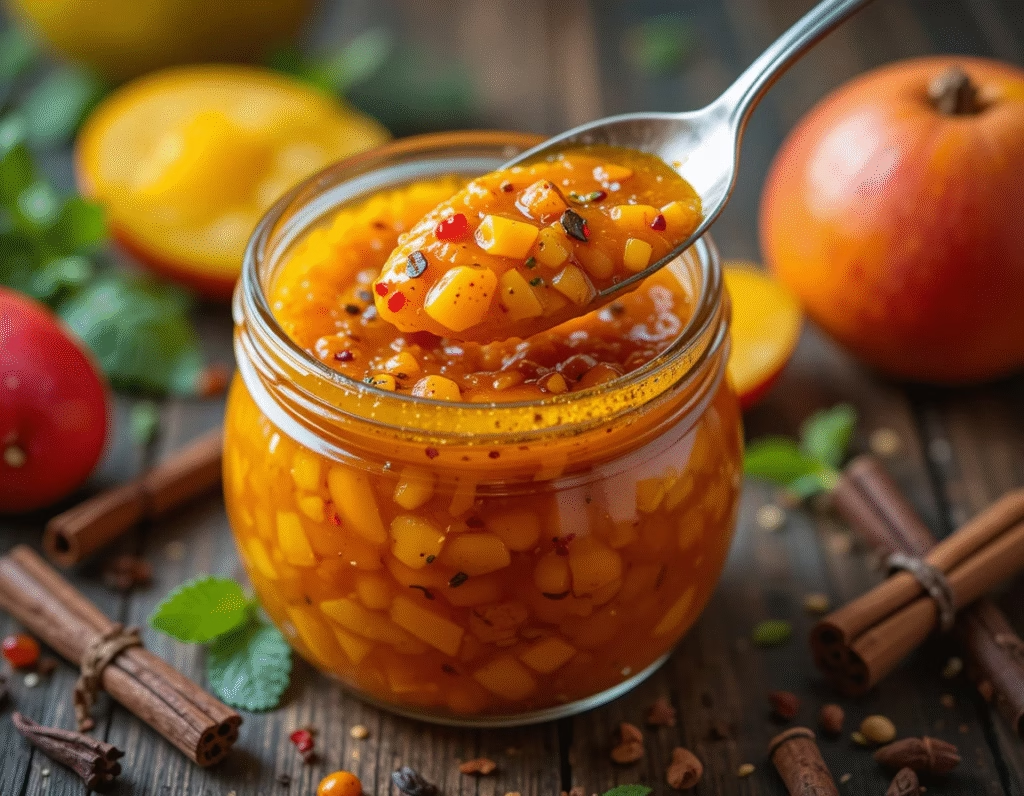
Conclusion
In the world of condiments and flavor-boosters, mango chutney is a true star. Its unique blend of sweet, tangy, and savory notes creates a flavor profile that transcends borders and elevates everyday meals into unforgettable culinary experiences. Whether you’re spooning it onto a sandwich, pairing it with cheese, glazing proteins, or simply enjoying it as a dip, mango chutney is endlessly versatile and endlessly satisfying.
What sets mango chutney apart is its beautiful balance. The sweetness of ripe mangoes combines with the sharpness of vinegar, the warmth of spices, and the depth of aromatics like onion and garlic to form a condiment that’s both bold and harmonious. With every bite, mango chutney delivers layers of flavor that make your taste buds dance.
Making mango chutney at home offers the additional benefit of customization. You can tailor the spice level to your liking, swap ingredients to fit dietary needs, and control the texture and thickness depending on how you want to use it. Homemade mango chutney is not only more flavorful than most store-bought versions, but it’s also fresher, healthier, and completely free from unwanted preservatives.
Incorporating mango chutney into your daily meals is also a fantastic way to reduce food waste and boost nutrition. Use it to brighten up leftover chicken or tofu, add flavor to plain rice, or bring a new twist to familiar dishes. Mango chutney isn’t just a condiment—it’s a creative tool that allows you to reimagine your meals with little effort and big payoff.

